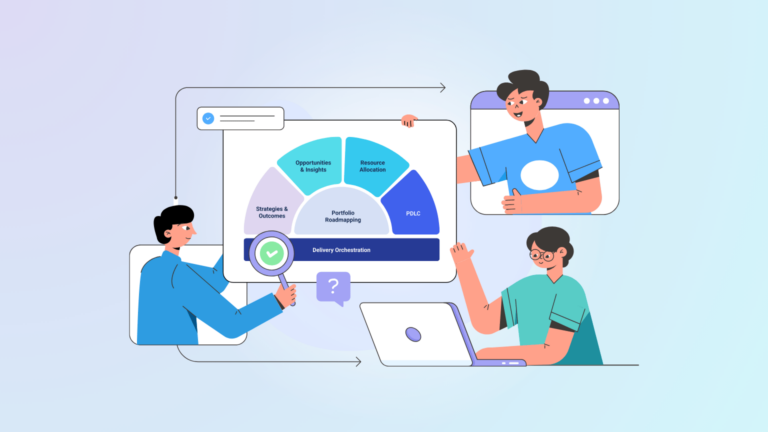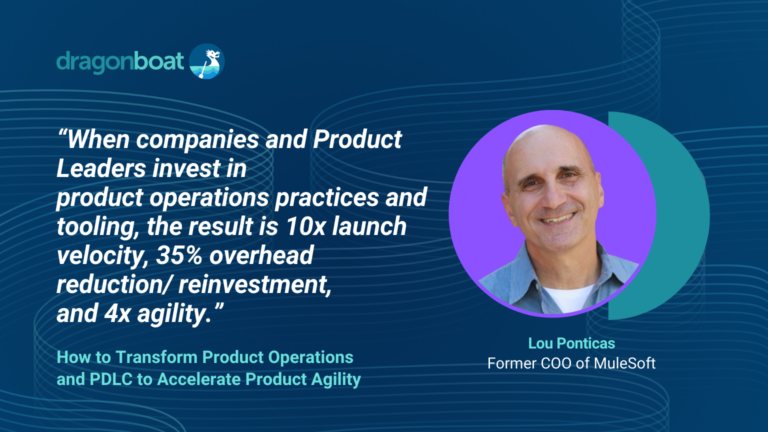Signs When You Need a Product Operations Platform
If you can’t instantly tell:
- where your product resources are allocated,
- what it takes to trade off one product initiative for another,
- the state of your key initiatives, or
- what outcomes (metrics) your product investments have produced last quarter or year
It’s time to have a product operations platform.
For most product organizations, the short answer to the question of “When?” is: As soon as possible.
“When you don’t have tools that allow you to quickly look at data and then use your time to prepare for discussions, you use all that prep time to create the data and you really don’t get the perspective, losing your audience.”
– Shelley Perry, MD of ScaleLogix
Your Product Operating Model Is the Difference Between Success and Failure
Every product company runs its own product operating model – It is the critical infrastructure of how the company conceives, builds, and launches products that deliver customer value and achieve business outcomes. In other words, your product operating model is how you turn product strategy and vision into product execution and impact.
This makes each organization’s product operating model central to the success or failure of the business – As well as the success or failure of the Chief Product Officers and Product Operations leaders who run it. A great roadmap is little more than a wish list until it is delivered and achieves the intended impact.
It’s no wonder that only 35% of most roadmaps are ever delivered, and why the average tenure of a Chief Product Officer is 18 months.
“As a CPO, you are a C-suite helping to drive the priorities. You want to use that information in that context at that time to actually help come up with decisions. And especially as major market changes, which we’re going through now, you want to be able to facilitate those discussions for better outcomes.”
– Shelley Perry, MD of ScaleLogix
Product operating models are too complex to run on spreadsheets, documents, and roadmapping tools.
Most product operating models don’t run on a unified platform using data, creating a big challenge because these models are complex and must:
- Allow multiple roles in the organization to participate (both collaboratively and autonomously) in shaping the products that are built,
- Orchestrate the interactions and cadences of all stakeholders who participate,
- Capture and incorporate all of the data produced by each person through every interaction, and make that data available for downstream decisions and actions.
What happens when this is done in spreadsheets, documents, and roadmapping tools?
Chaos. Loss of confidence. Loss of Trust.
Data captured in spreadsheets, documents, and roadmapping tools is disconnected and fragmented. This means that everyone (product leaders, stakeholders, board members, executives) acts on incomplete, outdated, and partial data. This, in turn, leads to poor decisions – and negative perceptions – ultimately paving the way to suboptimal outcomes for both the business and the personal careers of the product leaders involved.
Simply put – without a unified platform to run their product operating model, modern product leaders and their teams:
- Don’t know and can’t communicate what’s being built and why,
- Can’t effectively adapt to new information,
- Have no way to effect change,
- Lose stakeholder, executive, and board-level confidence and trust,
- Can’t deliver, fail on commitment.
“Prior to implementing a portfolio management tool, my teams were tracking only a 20% on-time delivery capability with virtually zero strategic initiative delivered.”
– Perry Steinberg, CPO at Symphony Talent
Why Dragonboat?
Dragonboat’s Product Operations Platform is purpose-build for product teams to run their entire product operating model through:
- Connected data: Dragonboat consolidates information from various sources, allowing for a holistic view of your product’s lifecycle.
- Connected participants: To lead Product across all teams and stakeholders, Dragonboat delivers a source of truth for everyone to make decisions.
- Connected interactions and processes: Whatever your current operating model, Dragonboat can be configured to enhance and not replace your processes. This adaptability makes it a seamless fit for any team.
- Quick setup: Setting up Dragonboat is straightforward and can be completed in just a few hours to a couple of days, depending on your organization’s complexity.
When is the right time to implement a product operations platform like Dragonboat?
Bringing your current product operating model to life in Dragonboat takes a few hours for a smaller team and a few days for a larger product organization. You may gain immediate benefits from interconnected strategic visibility and delivery visibility. Dragonboat can be configured to work for your existing operating model (no process change) – there is no downside to getting started.
“Don’t take the shortcut of implementing a new set of spreadsheets. They will never get you out of that outdated, siloed data state, and your operating debt will prevent your success.”
– Ryan Polk, CPO of StackOverflow
What are some common questions and concerns?
“I’m worried my team is too junior.”
All the more reason to implement Dragonboat’s Product Operations Platform sooner. With Dragonboat, you get a highly effective platform with world-class best practices built in, without the need to run a sophisticated process. Your team can do what they do today, while using data to improve how they operate tomorrow. With ready-made templates and a vibrant community of thousands product professionals ready to help, Dragonboat is perfect for product teams of all sizes and levels or maturity.
Check out how Nium used Dragonboat to uplevel their cadences and 4X their product launch speed.
“I don’t have a product ops person yet.”
This is precisely why you should implement Dragonboat today. Dragonboat is like your product operations sidekick, helping you identify opportunities to improve your product operating model with active alerting, insightful dashboards, and intuitive messaging. Dragonboat saves you a lot time finding essential information, clarifying operational questions, and identifying problems in your product delivery process.
Dragonboat’s world-class customer success team helps you make Dragonboat your own, handling all of the setup and onboarding of your team and their product operating model on the platform.
“The support from the Dragonboat team was top-notch and gave them the ability to feel comfortable evolving our processes to align with many of the capabilities we had in Dragonboat.”
– Ryan Polk, CPO of StackOverflow
“Our Jira is a mess.”
This is very common – Dragonboat actually helps you see the signal above the noise by putting in things like goals, themes, metrics or initiatives that serve as the strategic layer above the Jira noise.
With Dragonboat, you set those up first, then connect Jira and map the things that matter in Jira to those strategic items. This brings clarity and focus to your product execution in Jira – and allows everyone to focus on the epics and stories that drive outcomes in the business.
“Our Jira instance is crazy. Now my product managers maintain their backlogs, the linkages back to our features, initiatives and our strategies. At the CPO level, I’m usually sitting in Dragonboat, never in Jira. I can start to talk to the executive team about what we’re doing and what trade-offs we need to make in the roadmap.”
– Ryan Polk, CPO of StackOverflow
“We don’t have the budget for a new tool.”
Dragonboat more than pays for itself in the first few months alone. Dragonboat helps you identify wasteful work that doesn’t move the needle on your goals, and prioritize work that does. This unlocks up to 80% more engineering capacity with your existing team.
“We’re rolling out a new process.”
This is the perfect time to deploy Dragonboat! Standing up your new process in a platform, using data is the best way to measure and optimize your process.
Running a new process on spreadsheets, presentations, traditional roadmapping or project management tools disconnects it from the rest of your product operating model. This creates room for execution error and makes you heavily reliant on human intervention to run your new process.
You need a platform to run all of your product operating processes – and Dragonboat is the only one flexible enough to do that.
Consider how Dragonboat helped ECS during their digital transformation journey.
“We just signed with a roadmap tool. The rollout has been rough but the contract still has 6 months remaining.”
We can work with you on this front – but roadmapping tools are very narrow in how they plug into your product operating model. This is the reason most companies we talk to outgrow their roadmap tools and end up changing them out frequently.
Roadmapping tools can be rigid, siloed and still fall short of being a complete operating platform for your end-to-end product needs. You will never outgrow Dragonboat because it is flexible enough to implement your entire product operating model and to evolve it as your processes change.
“We’ve just merged with another company.”
This is Dragonboat’s bread and butter – we actually accelerate merger success by helping you quickly see across many product teams, instances and entities. This reduces duplicative work, aligns everyone around one north star and accelerates your time to value in a merger scenario.
Learn how we help organizations going through a merger or acquisition here.
To demonstrate how we help organizations tackle organizational complexity, Rob Seidman of US Bank calls Dragonboat his “Bible”. Dragonboat is the source of truth that helped Rob get 30 different engineering teams to code 3,500 epics in 9 months.
“Dragonboat is our Bible. If it doesn’t exist in Dragonboat, it does not exist. Everything has to be there because we are managed by it. And this is how we deliver value to the user and to the business of which we serve.”
– Rob Seidman, CPO of POS Lending, US Bank
Is there ever a wrong time to bring in Dragonboat?
Yes, there are a few occasions we recommend a wait period:
- You are a very small startup finding initial product-market fit – There are just a couple of people and rapid iteration is needed, while alignment and clarity are easily achievable.
- You have a very large organization going through major transformation, where the current product operating model needs a change that is yet to be decided. – In this instance, we recommend waiting until organizational alignment on the new operating model. Once that occurs, it would be perfect timing to implement Dragonboat and transform your product organization.
Building a Future-Proof Operation
Adopting Dragonboat means more than just upgrading your tools. It means preparing your organization to be flexible and scalable amidst the uncertainties of the tech world:
- Flexibility and scalability: As your company grows, Dragonboat grows with you. It accommodates increasing complexity with its product suite and helps maintain strategic focus, regardless of how your product portfolio expands.
- Community and expert support: Dragonboat comes with access to a vibrant community and a team of experts who are always ready to assist. This support network is invaluable for troubleshooting, learning best practices, and continuously improving your operations based on collective insights.
Take the next steps
Choosing Dragonboat is choosing to invest in your Product Operating Model. It’s about making a strategic decision that will pay dividends in enhanced decision-making, improved team alignment, and ultimately, faster and more effective product delivery.
Ready to get started? Book a demo today!




